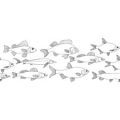Understanding the Basics: Lures and Live Bait Explained
If you’re just getting started with fishing in the United States, one of your first big decisions will be choosing between lures and live bait. Both options have their pros and cons, and understanding the basics is crucial for any beginner angler. Lures are artificial objects designed to mimic prey and attract fish through movement, color, and vibration. They come in all shapes and sizes—from flashy spinners to realistic soft plastics—and are reusable, making them a favorite for many American anglers who enjoy the challenge of “fooling” a fish. On the other hand, live bait uses real, natural food sources like worms, minnows, or crickets to entice fish. This method often appeals to beginners because it relies on a fish’s instinctive response to food, sometimes making it easier to get bites.
| Lures | Live Bait |
|---|---|
| Artificial, reusable | Natural, single-use |
| Mimics prey movements | Relies on real scent/taste |
| Variety of types/styles | Limited by available species |
| Great for covering water quickly | Effective for stationary fishing |
| Requires more technique/skill | Often easier for beginners |
The key difference every new angler should know is that lures rely on presentation and action—how you move them in the water—while live bait depends more on natural scent and behavior. Choosing between the two often comes down to your fishing goals, local regulations, and the type of fish you’re after. Understanding these basics will help set you up for success as you start your angling journey.
2. Pros and Cons: Comparing Lures and Live Bait
When deciding between lures and live bait as a beginner angler, it’s important to weigh the pros and cons of each option. Both have their unique advantages and drawbacks depending on your fishing goals, local conditions, and personal preferences. Below is a side-by-side comparison to help you make an informed decision:
| Lures | Live Bait | |
|---|---|---|
Convenience |
Lures are easy to store, transport, and reuse. You don’t need to keep them alive or fresh, which makes them ideal for spontaneous trips. | Live bait requires proper storage (coolers, aerators) to stay alive and fresh. It can be messy to handle and isn’t always allowed in certain locations. |
Effectiveness |
Lures can mimic various prey and trigger predatory instincts. They work especially well for aggressive fish or when targeting specific species with matching colors and actions. | Live bait often proves irresistible to many fish species. Its scent, movement, and natural appearance can entice even finicky fish to bite. |
Cost |
While some lures can be pricey upfront, they are reusable and durable if not lost or damaged. | Live bait needs to be purchased fresh for every trip, so costs add up over time. Some specialized baits may also come at a premium price. |
Availability |
Lures are widely available at tackle shops, outdoor stores, and online retailers year-round. | Live bait availability depends on season, region, and local regulations. Certain types may not be accessible in all areas or during all seasons. |
Quick Takeaway
Lures offer greater convenience and long-term savings, making them perfect for anglers who value flexibility and minimal hassle. Live bait often outperforms lures in terms of pure effectiveness, especially when targeting cautious or inactive fish. Consider your local waters, target species, budget, and fishing style when choosing the right approach for your next outing.
![]()
3. Species and Situations: When to Use Lures or Live Bait
When deciding between lures and live bait, understanding which fish species you’re targeting and the specific fishing situation is crucial. Certain species tend to react more aggressively to artificial lures due to their predatory instincts, while others are best caught with live bait that mimics their natural food. Additionally, your choice can depend on whether you’re fishing in freshwater or saltwater, the time of year, and even local regulations. Here’s a quick reference table to help you make the right decision:
| Fish Species | Best Option | Recommended Situations |
|---|---|---|
| Bass (Largemouth & Smallmouth) | Lures | Spring & Summer, active feeding times, structure-heavy lakes |
| Trout | Live Bait | Cools streams/rivers, early mornings, natural insect hatches |
| Panfish (Bluegill, Crappie) | Live Bait | Ponds/lakes, spring spawning season, shallow waters |
| Northern Pike/Muskie | Lures | Larger lakes/rivers, clear water, summer & fall seasons |
| Catfish | Live Bait | Muddy rivers/lakes, night fishing, year-round but especially summer |
Where you fish also matters. In heavily fished public lakes, wary fish might shy away from artificial presentations and respond better to natural baits. On the other hand, if you’re covering lots of water or targeting aggressive feeders like bass or pike, lures let you work efficiently and trigger reaction strikes. Seasonal changes also play a role: during colder months when fish metabolism slows down, live bait often outperforms lures because it can be presented slowly and naturally. Always check local regulations as some areas restrict or prohibit the use of certain types of live bait to prevent the spread of invasive species.
4. Tackle Box Essentials: What Every Beginner Should Carry
Getting started as a beginner angler means being prepared for any situation on the water. Whether you decide to fish with lures or live bait, having the right gear in your tackle box makes all the difference. Here’s a quick guide to must-have items and practical tips for assembling a versatile setup that works for most American freshwater fishing spots.
Lure Must-Haves for Beginners
- Soft Plastic Worms: Versatile, effective for bass, and easy to rig on different hooks.
- Spinnerbaits: Great for covering water quickly and attracting predatory fish like bass and pike.
- Spoons: Ideal for mimicking wounded baitfish—simple to use and cast far.
- Crankbaits: Perfect for exploring different depths; select a couple in natural colors.
- Panfish Jigs: Small and effective for bluegill, crappie, and other panfish species.
Live Bait Setups Every Beginner Needs
- Bait Hooks (Various Sizes): For worms, minnows, or dough balls—choose sizes based on target species.
- Split Shot Sinkers: Add weight to help baits sink at the right depth.
- Bobbers (Floats): Essential for suspending live bait off the bottom and detecting bites.
- Bait Container: Keep worms or minnows lively and accessible throughout your trip.
Tackle Box Packing Tips
- Select a small, compartmentalized tackle box to keep gear organized.
- Add essentials like needle-nose pliers, line clippers, extra fishing line, and a basic first-aid kit.
- Pack a mix of lures and live bait supplies so you’re ready to adjust based on what fish are biting.
Tackle Box Essentials Table
| Lure/Bait Type | Recommended Use |
|---|---|
| Soft Plastic Worms | Bass, general freshwater fishing |
| Spinnerbaits | Bass, pike, covering water fast |
| Spoons | Bass, trout, casting distance |
| Panfish Jigs | Panfish (bluegill, crappie) |
| Bait Hooks/Sinkers/Bobbers | All-around live bait rigs |
Pro Tip:
If you’re unsure which option to use—lures or live bait—bring both! Observing local anglers at your favorite American lake or river can also help you fine-tune your choices. A well-stocked tackle box means you’re always ready for action and learning every time you hit the water.
5. Regulations and Ethical Considerations
When choosing between lures and live bait, its essential for beginner anglers to understand that fishing regulations and ethical practices can vary significantly across the United States. Local laws often dictate what types of bait are allowed, specific seasons, and even which species you can target. For example, some states restrict the use of live bait to prevent the spread of invasive species or protect native fish populations. Always check with your state’s Department of Natural Resources or Fish and Wildlife Service for current regulations before heading out.
Common U.S. Bait Regulations
| State | Live Bait Restrictions | Lure Requirements |
|---|---|---|
| California | No transport of live baitfish between water bodies | Barbless hooks in certain areas |
| Florida | Certain species prohibited as bait (e.g., non-native fish) | No major restrictions; check local rules |
| Minnesota | Bait must be purchased from certified dealers | Artificial lures encouraged for some lakes |
Ethical Fishing Practices for Beginners
- Always dispose of unused bait properly—never release live bait into the wild unless it’s from the same body of water.
- Use circle hooks when using live bait to reduce deep hooking and increase survival rates of released fish.
- Practice catch-and-release responsibly by handling fish gently and minimizing their time out of water.
Why Ethics Matter
Being a responsible angler means not only following the law but also considering the impact your choices have on local ecosystems. By respecting regulations and practicing ethical fishing, you help preserve fisheries for future generations and contribute to healthy waterways across America.
6. Making Your Choice: Tips for Beginners
Deciding whether to use lures or live bait can feel overwhelming for new anglers, but with a little thought and experimentation, you can find the option that fits your style best. To help you choose, consider the following tips based on your personal goals, local fishing spots, and learning preferences.
Assess Your Fishing Goals
Think about what you want out of your fishing experience. Are you looking for an active, hands-on approach where technique matters? Or are you more interested in relaxing by the water and waiting for a bite? Lures typically require more casting, retrieving, and movement, while live bait allows you to set up and wait.
Consider Your Local Waters
The type of fish found in your area and the regulations on bait use can influence your choice. Some waters prohibit certain live baits or have restrictions to prevent the spread of invasive species. Check with local tackle shops or state wildlife agencies for guidance on what works best locally.
| Factor | Lures | Live Bait |
|---|---|---|
| Active vs. Passive Fishing | Active (casting & retrieving) | Passive (wait for bites) |
| Local Regulations | Usually allowed everywhere | May have restrictions |
| Target Species | Best for predatory fish (bass, pike) | Great for panfish, catfish, trout |
Embrace Learning Through Experience
No article or video can replace time spent on the water. Try both lures and live bait during different trips. Notice which method feels more enjoyable and productive for you. Keep notes on conditions like weather, water clarity, and fish activity—these details will help you refine your approach.
Starter Tips for Each Method
- If you’re using lures: Start with basic spinnerbaits or soft plastics. Practice casting accuracy and retrieval speeds.
- If you’re trying live bait: Use a simple bobber rig with worms or minnows. Focus on setting the hook at the right moment.
Your Next Steps
The key is to stay curious and flexible. Over time, most anglers develop a favorite method or use both depending on the situation. Don’t be afraid to ask questions at local bait shops—they’re often happy to share advice tailored to your area. Remember, every cast is a chance to learn!


